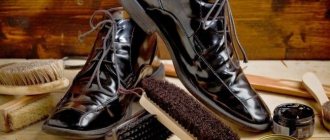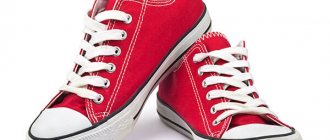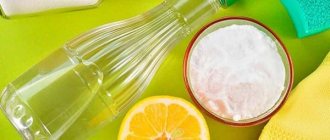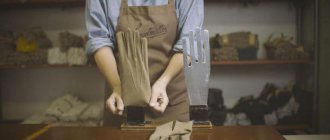This article was prepared by our beloved partners - the #GMfood - an online store of superfoods and craft eco-products.
Just for registering in the store you will receive 300 rubles to your personal bonus account and 2 more interesting gifts (Grab your gifts here)In the store's assortment you will find not only superfoods, but also healthy sweets, breakfasts, herbal teas, peanut butter, master classes for body health and facial beauty, and this is only a small part of the goodies and benefits!
Subscribe to Instagram #GMfood using this link and regularly receive new PP recipes with superfoods, see useful guides to the world of proper nutrition, and also look for gifts hidden under the link in the profile!
Clothes care
Surely, many women are concerned about the issue of caring for their clothes. Each item has its own service life and over time loses its shape, wears out and breaks. In order for a thing to retain its original appearance longer, it needs to be properly cared for.
Clothing is a product that is worn by a person and has aesthetic functions. It protects the human body from the negative influence of the environment. Can be made of fabric, leather, fur, knitted fabric.
Source Wikipedia
Caring for clothes made from different materials has its own nuances.
Silk
Caring for silk clothing requires a delicate approach to things and careful handling. They should only be washed with liquid detergents, which must be mixed well in water. Such things cannot be bleached; the fabric may simply tear. You can soak for no more than 10 minutes.
When doing push-ups, the item should not be twisted. It is best to fold it several times and squeeze it with your palms to let the water drain out. After this, dry in a horizontal position, placing it on a terry towel to absorb moisture, then you can hang it up.
If you need to iron an item, set the iron to the lowest temperature and turn the item inside out. Before putting it in the closet, to avoid wrinkles appearing on it, make sure that the item has cooled down after ironing.
Made from wool
Woolen clothes should be stored folded in bags to prevent dust and dampness.
Before washing, such items should be soaked for 20 minutes in cool water using liquid detergent.
You shouldn't squeeze things out either. After the water has drained, it is best to lay them out on a clean, dry towel. When it gets wet, change the towel. And, of course, you can’t hang woolen items on radiators.
Made from knitwear
Knitwear, like silk, is a capricious fabric. Such things quickly become pelletized and lose their attractive appearance.
To prevent this from happening, knitted items should be washed in water at a temperature of 30 degrees with liquid detergents that do not contain bleach. In a washing machine, you can wash such things in the “delicate wash” mode, and the spin function should be set at the lowest speed, or it is better to turn it off altogether.
If the item has buttons, they should be fastened and then turned inside out. Dry flat so that there are no wrinkles, and iron with steam through the fabric. Knitted items should be stored on a shelf that is not filled to capacity with different things.
Leather
Leather items require careful care. If the item gets wet, it should be wiped with a dry cloth and allowed to dry. If it is snowing or raining outside, your raincoat or jacket should be soaked in a water-repellent agent before going out.
To get rid of creases, these places can be wiped with a napkin soaked in glycerin.
Leather items cannot be washed. If they are heavily soiled, they should be dry cleaned. It is best to store them in bags made of natural materials.
Fur
If a natural fur coat gets wet, it should be shaken and hung to dry in a well-ventilated area.
For storage, fur products need dry air and ventilation, so it is better to make sure that the fur coat hangs freely in the closet and is not pressed against other things or against the closet wall.
Fur hats should be stored on special blanks, otherwise they will lose their shape.
Effective means
Selected taking into account the material. It’s easier to decide on products for products made of smooth dark leather. Useful for daily care:
- rough water;
- soap solution (for small stains);
- specialized shampoo;
- moisture-repellent products;
- acrylic and silicone sprays (to renew the coating);
- wax (responsible for softness);
- sponges with oils (remove small particles of dirt, prevent the top layer from becoming coarser, and can further enhance water-repellent properties)
- products that restore shine.
With some exceptions, glycerin and castor oil can be used. The substances are applied evenly with a cotton swab. If necessary, the procedure is repeated, but you should not often resort to folk remedies, as they clog the pores.
Important! Glycerin is also effective against ink, and aspirin dissolved in a small amount of water will help get rid of blood. Well, diluted ammonia will help refresh the color of a white jacket.
Suede care is based on sprays with different effects. The delicate structure of the product prevents fibers from sticking together and allows you to remove dirt without the use of brushes or brute force. When handling nubuck and velor you should be even more careful. The main recommended product is a specialized shampoo.
If the jacket is torn or has lost color, it can be repaired at clothing repair shops in your city. Find a workshop near your home.
How to properly store clothes?
Very often, during wear, sweaters stretch, and “bubbles” appear on the knees of tights and jeans, and the shoulders of coats and suits become deformed.
How to store things to avoid this?
To store clothes - dresses, blouses, shirts, jackets - you need to use hangers. This way they will retain their shape. You should not hang several dresses, blouses or shirts on one hanger at once, they will wrinkle. For each item, it is better to choose suitable hangers. Their width should correspond to the width of the shoulders of the garment.
Skirts should be stored on hangers with clothespins. Trousers folded in half should be hung on a crossbar in the closet.
Sweaters, cardigans, and woolen items on hangers will stretch and, as a result, lose their shape. Therefore, it is better to fold them and store them on a shelf. Jeans can also be stored folded on a shelf.
When worn, some items become covered in pellets and lose their attractive appearance. This is a process that is related to the characteristics of the fiber. But they are easy to get rid of using a special machine. It is compact and runs on batteries. It is easy to clean - you just need to remove the tank and throw away its contents. After that you can continue to use it.
An indispensable means of caring for clothes is a cleaning roller. It can be used to clean clothes from dust, small debris, and pet hair.
After the end of the season, things need to be put away for storage. It is better to store coats, jackets, and items made from expensive fabrics in cases. They will protect them from dust.
Optimal storage system
If clothes and shoes are stored carefully and neatly, they get dirty less, are not saturated with dust and odors, and do not wrinkle. This means you won’t have to clean it, wash it, air it, or iron it again. Plus, if every item has its own place, it saves a lot of time on cleaning. What do we expect from a storage system, and how can we achieve it?
1. Keeping clothes and shoes presentable.
First of all, get decent hangers. For outerwear and suits, wooden, polished hangers with an extended edge are best suited; for dresses, shirts, blouses, flocked or covered with fabric. A mandatory requirement is that the hanger matches the size of the clothing. In this case, it does not wrinkle, the fabric is less stretched and deformed.
Lifehack! Do not rush to put on a freshly ironed item, otherwise it will immediately become wrinkled. Allow the fabric to cool, the fiber to straighten and “come to its senses” after exposure to hot temperatures. The best option is to iron your clothes after washing, not before going out.
To protect outerwear and expensive outfits from dust, moisture, and friction, pack them in covers made of non-woven material. Make sure that the trunk is of the required length, and that the hem of your fur coat or evening dress does not turn up.
The ideal storage option for dress shoes is cardboard boxes, plastic boxes, and pull-out boxes. Multi-section trunks are designed for sports and light summer shoes with flat soles.
Don’t forget about shoe accessories that will help fix the shape and prevent leather deformation (lasts, form holders for boot tops), and eliminate unpleasant odors (sachets with adsorbents and flavors).
2. Convenient search
In order not to waste time searching for the necessary wardrobe items, equip it with convenient organizers.
When choosing covers, trunks for clothes, shoes, linen, pay attention that they have transparent inserts or a plastic cover.
Linen and other small items are best placed in flat organizers with compartments. This allows you to keep similar items in one place, in a horizontal plane, which greatly simplifies their search.
Housewives complicate their lives by hanging things one by one. If you have a shortage of space in your closet, purchase multi-level hangers for blouses and shirts, which will save space and maintain the visual accessibility of clothes.
3. Organize your closet
Items of clothing scattered in different places are the main source of clutter in the room. Having a sufficient number of organizers, it is not at all difficult to determine their place.
Many “lazy” housewives appreciated all kinds of boxes, shelving baskets, trunks for storing things. They are roomy. Thanks to their rigid design, they can be stacked on top of each other, using vertical space. And even if some mess arises, it moves inside the container, and visually the shelf looks neat.
Lifehack! If the area of your apartment allows, purchase a dressing room closet for sets of clothes that you wear daily or put together “for tomorrow.” This allows you to prepare clothes the night before without hanging them on the closet door, back of a chair, etc.
How to wash clothes correctly?
Proper washing is of no small importance in caring for clothes. Clothes are subjected to severe stress during washing. High temperature, detergents, spinning - all this negatively affects the fiber, and over time things become unusable.
To make them last longer, you should not wash them too often. If you just need to freshen up an item, you don't have to wash it. You can use a hand steamer, and then your clothes will look much neater. Under steam, the item will smooth out and visually look as if it had been washed.
The main advantage of a handheld steamer is that it is easy to use. With its help you can quickly refresh your clothes; it can easily cope with lace, appliqués and other small details. Another plus is that you can use it to iron curtains and tulle directly on the cornice.
Preparing for washing
Before washing, check all pockets and remove the contents from them so as not to accidentally damage the machine or spoil the item. Close zippers to prevent damage to other items and the drum. Unfasten the buttons to prevent them from coming off during washing.
To protect things from fading, it is better to turn them inside out.
Sorting things
It is preferable to wash light items with light items and dark items with dark ones. White – separately.
Items also need to be sorted by fabric type. Items made from fine fabric cannot be washed with items made from coarse fabric. Heavily soiled items should be washed separately.
It is better to wash colored items at 30 degrees, as they may fade.
Temperature selection
The maximum allowed temperature for washing is indicated on the item's label. The higher the temperature, the more negatively it affects things. Therefore, if the item is not too dirty, it is better to wash it in warm water.
Using laundry bags
To avoid washing underwear, swimsuits, and tights by hand, you can use laundry bags. They will help maintain their appearance. Before loading, close the bra hooks to prevent them from damaging the lace.
The bags can be used to wash items that require hand washing. You just need to select the desired mode and spin at no more than 600 rpm.
Choosing washing powder
“Hand wash” powder is not suitable for washing machines. By forming foam, it prevents things from spinning, and as a result they do not wash well.
Universal powders are suitable for all types of fabric. But it’s still better to buy powder for different types of fabric, because powder intended, for example, for washing things made of cotton, linen, wool, and synthetics copes with its task better. And things retain their shape and color for a long time.
There is a powder for washing colored fabrics. It keeps things bright longer. To wash items with lace, delicate fabrics, microfiber and knitwear, it is better to use liquid detergents with softeners. They will not ruin thin fabric.
To prevent the fabric from fading or shrinking, you can add a spoonful of vinegar solution to the water. Powders with enzymes, i.e. protein enzymes, are good at removing grease stains, blood, sauces, ice cream. But things should be washed at a temperature no higher than 50 degrees.
If you put more powder than necessary, white stains will remain on things, and excess powder will remain in the seams.
How to wash white clothes
White items should be washed separately from other clothes. No need to get carried away with bleach. It destroys fabric fibers and reduces wear time.
If there are stains on the collar and cuffs, they should be washed with laundry soap and left for 30 minutes. Then rinse and wash in the washing machine.
Regular baking soda will help make things whiter. Dissolve 1 tablespoon of baking soda in a glass of water, add to the powder and wash at 60 degrees.
How to wash jeans
To prevent jeans from losing color, they need to be turned inside out before washing. It is better to use mild detergents for washing. They should be washed at a temperature of 30 - 40 degrees and do not use a strong spin.
Dry horizontally, upside down.
DECODING SIGNS ON LABELS
And, as they say, the last but not the least - the treasured decoding of the icons on the labels. Look at them more often - and “horror-horror” will no longer happen to your favorite things
1. Hand wash. 2. Washing is prohibited. 3. Hand wash only at a maximum temperature of 30°C, do not rub or wring. 4. Hand or machine wash at a temperature not higher than specified. 5. Hand or machine wash. Carefully adhere to the specified temperature, do not subject it to strong mechanical processing, rinse, gradually turning to cold water, and when spinning in the washing machine, set the centrifuge to a slow setting. 6. Very delicate wash in plenty of water, minimal mechanical processing, quick rinse at low speed. 7. Washing with bleaches containing chlorine is allowed. Use only cold water, make sure the powder is completely dissolved. 8. When washing, do not use products containing bleaches (chlorine). 9. Ironing is allowed. 10. Ironing is allowed at a maximum temperature of 110 °C. The same rules apply to synthetic fibers: nylon, polyester, acetate and others. Use a cloth pad, do not use steam. 11. Ironing is allowed at a maximum temperature of 150 °C. Suitable for wool and mixed fibers with polyester and viscose. Use a damp cloth. 12. Ironing is allowed at a maximum temperature of 200 °C. Acceptable for linen and cotton. You can slightly moisten the product. 13. Dry clean only. 14. Dry cleaning with any solvent. 15. Cleaning with hydrocarbon, ethylene chloride and monofluorotrichloromethane only. 16. Cleaning using only hydrocarbon and trifluorotrichloromethane. 17. Cleaning only with hydrocarbon, ethylene chloride and monofluorotrichloromethane with limited addition of water, control of mechanical stress and drying temperature. 18. Cleaning only with hydrocarbon and trifluorotrichloromethane with limited addition of water, control of mechanical stress and drying temperature. 19. Allowed to wring and dry in a washing machine. 20. It is not allowed to spin or dry in a washing machine. 21. Dry at a warm temperature. 22. Dry at hot temperature. 23. After spinning, vertical drying is allowed. 24. Dry without spinning. 25. Dry on a horizontal surface.
How to get rid of stains on clothes?
The easiest way is to use a stain remover. After using it, you need to soak the item, and if the stain is not removed, wash the item in the washing machine.
You can try to remove blood stains by soaking your clothes in cold water. Wine stains should be sprinkled with salt before washing.
To remove traces of lipstick, nail polish, and greasy stains, you need to wipe them with alcohol or nail polish remover, and then soak them before washing.
If soil stains remain on your clothes after gardening, you can soak them in water with a small vinegar solution before washing.
Some people suffer from excessive sweating and get sweat stains on their clothes under their armpits. You can get rid of them with lemon juice. aspirin, hydrogen peroxide or baking soda. To get rid of stubborn stains, you can prepare a solution of water and baking soda and soak the item for 30 minutes. Then rinse and wash.
You can return shiny fabric to its previous appearance using a soft brush dipped in a vinegar solution.
Cleaning
All owners of such products simply must know how to clean leather shoes. This material quickly becomes dirty, dust settles on it, and traces of water drops appear.
To clean leather shoes at home, just take soap, a large basin or bucket, a soft cloth or brush.
If you get caught in the rain and your boots get completely wet, dry them first.
You can also clean leather shoes with professional cosmetics; your budget and abilities play a role here.
How to clean leather shoes:
- Take a cloth or brush, brush off the dust, and clean the dirt from the sole. If pebbles remain on the shoes, they will scratch the surface.
- Then it needs to be washed. How to wash: use professional cosmetics, soap solution or glass cleaner. It is advisable not to do this with water.
- Treat the dried material with mink fat, wax or a water-repellent compound. They do not allow water to be absorbed.
- Finally, cream is applied and the product is treated with a polishing compound and a velvet cloth.
That's the whole secret of the step-by-step application of professional cosmetics.
As you can see, caring for new leather shoes and old ones is not at all problematic. Just follow the step-by-step procedure, do everything carefully and be happy with the result.
Shoe care
Shoes will last a long time if you treat them correctly. Do not remove shoes by pressing down on the heel with the other foot, as this may deform the heel. Put on your shoes using a special horn.
After each time you go outside, clean your shoes from dirt and then lubricate them with shoe polish.
Shoe care products must be selected based on color and material and applied only to clean shoes.
It is best to store shoes in transparent boxes. This makes it easier to find the right pair and, in addition, the boxes will protect the shoes from dust and moisture.
In an automatic machine
Can leather shoes be washed? This is one of the most frequently asked questions that product sellers and repairers hear.
They can be washed by hand; such shoes cannot be processed in a machine. An irreparable disaster can happen to both new and old shoes.
Leather requires special care, and machine washing is not suitable.
Cleaning leather shoes at home is only allowed with rags, special products and brushes. Only manual removal of contaminants is permitted. All stains are washed with a cloth in a basin.
Shoes washed in an automatic machine will shrink and lose their appearance.
It is washed in soapy water. It is prohibited to use washing powder, bleaches or stain removers for washing. Otherwise, damage will appear on the shoes.
How to wash leather shoes by hand:
- Wash natural leather with a soapy cloth; artificial leather can be immersed in water.
- Lather the detergent well and apply only foam, or apply it to a damp cloth and wipe the surface.
- For a more thorough cleaning, use ammonia. Add 5-6 drops to the soap solution.
- Insoles and laces should be cleaned separately. The same compositions can be used as a care product. Wash them with soap, you can use washing powder. Then rinse off the residue with water and set to dry.
Leather shoes, boots or shoes are dried on the balcony, but in the shade. In winter, they are placed in a room near special electric dryers.
How to care for clothes at home
In order for clothes to retain their attractive appearance longer, you need to be able to care for them.
When purchasing an item in a store, you should read the recommendations on the label, where the manufacturer indicates how to properly care for it. After all, if it states that the item cannot be washed, but must be dry cleaned, you may change your mind about buying it.
When washing and ironing, set the desired temperature and store it correctly. It is best to store things in closets and chests of drawers that close tightly. There they are protected from sunlight and dust. To prevent clothes from absorbing odors, the closet should be ventilated regularly.
Caring for things made from different materials has its own nuances. To ensure that your clothes always remain in good condition, you need to follow a number of simple rules:
- Heavy sweaters, cardigans, knitted dresses should not be left on hangers, they will stretch;
- Select hangers according to the size of your clothes. Narrow ones will cause things to sag, while wide ones will lead to the formation of bubbles. For cashmere items, it is better to choose soft hangers;
- Items that come into contact with the body should be washed after each wear, otherwise the smell of sweat may appear;
- After each cleaning, clothes should be hung in the closet to acquire the desired shape;
- Items made of fleecy fabrics are best stored in covers to avoid dust;
- Clean and dry items in an appropriate manner.
Cotton items can be washed at high temperatures, and colored items can be washed at 30-40 degrees. To prevent things made from natural silk from losing their properties, it is best to wash them by hand in warm water. After this, rinse in warm and then in cold water. There is no need to squeeze them, you can just gently squeeze them with your palms so that the water runs out. Dry on a horizontal surface away from heating devices.











